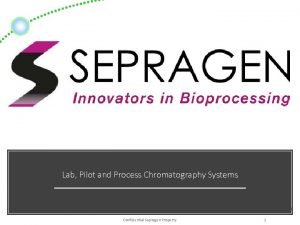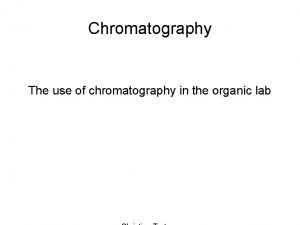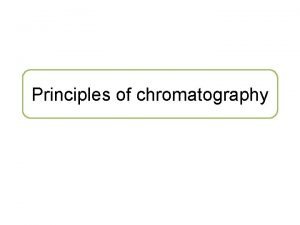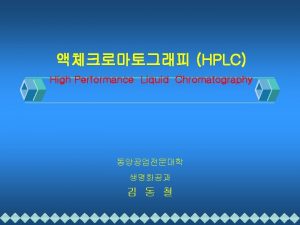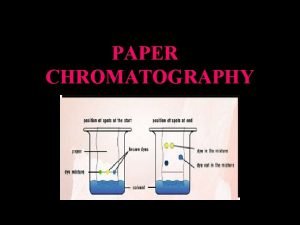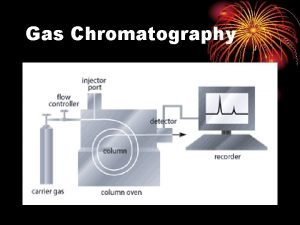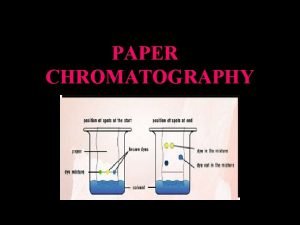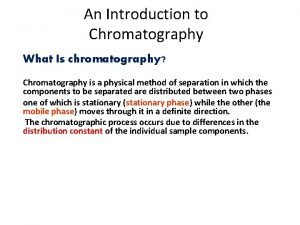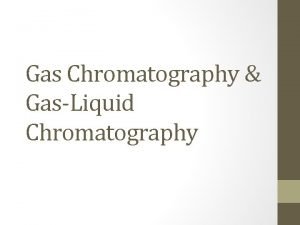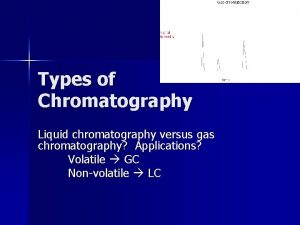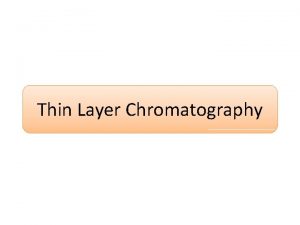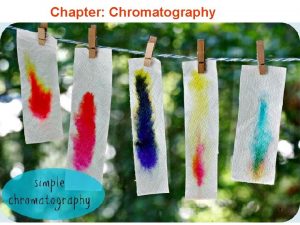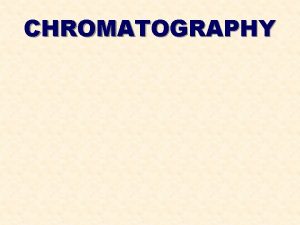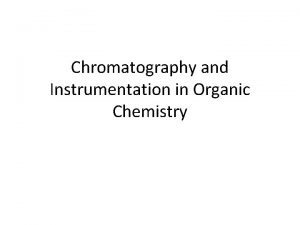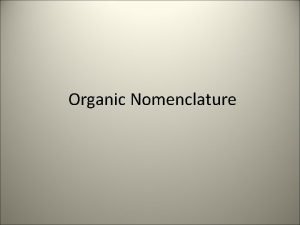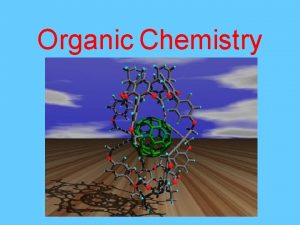Chromatography The use of chromatography in the organic























- Slides: 23

Chromatography The use of chromatography in the organic lab

Agenda ● Introduction ● Very little theory ● Stationary phase ● Mobile phase ● Analytical methods ● Preparative methods ● Gravitational/Flash chromatography ● Dry Column Vacuum Chromatography

Theory ● Distribution coefficient ● Theoretical plates ● HETP ● Band broadening

Theory

The stationary phase ● Silica ● Aluminiumxoid ● Basic ● Acidic ● Activity ● E vs T ● Reversed-phase silica ● Cellulose, florisil, Bio. Beads, Sephadex

The stationary phase ● Silica Particle size ● 63 -200 μm - Gravitation/MPLC ● 40 -63 μm - Flash/MPLC ● 15 -40 μm - DCVC ● 5 -15 μm – TLC/HPLC

The mobile phase ● Not as restricted as the stationary phase ● Solvent parameters ● Polarity ● Selectivity ● Solvent groups ● Binary eluent mixtures



The mobile phase

Analytical methods ● ● Automated techniques ● Analytical HPLC ● LC-MS ● LC-NMR TLC

TLC ● Aluminiumoxide - F 254 ● Reversed phase silica – No indicator! ● Silica - F 254 ● 2 D-TLC ● TLC-MS ● TLC-NMR

TLC ● Development / visualisation ● UV ● 2, 4 -DNPH ● Ninhydrin ● CAN ● Many more!

Preparative methods ● Preparative TLC ● Easy transfer of results from analytical TLC ● Easy visualisation ● No need for further TLC-analysis ● Small amounts per plate

Column Chromatography ● HPLC ● Small particle size / High Pressure ● Very expensive columns ● Typically reverse phase ● Elaborate setup, DAD, fraction collector ● Great resolution ● Typically several runs needed for prep. scale ● Pre-columns and extensive wash needed

Column Chromatography ● Gravitational/classic column chromatography ● ● Slurry packed with a solvent reservoir Typically done with 40 -63μm or 63 -200μm particle size ● Good resolution possible on “known columns” ● Time consuming ● Often done “blindly” ● Can be done faster with pressure ● Huge amounts of solvent needed ● Eluent system and column length often guestimated

Column Chromatography ● Flash Column Chromatography ● Very narrow definition ● 45 -63μm particle size ● Defined flow rate: 5 cm / min ● Eluent mixture determined by TLC – Rf = 0. 35 ● Crude method - resolution only trivial ΔRf ≥ 0. 15 ● Optimum packed length = 18 cm ● 1 L solvent per gram loaded compound needed ● Amounts above 10 g are non trivial

Column Chromatography ● Dry Column Vacuum Chromatography

Column Chromatography ● Dry Column Vacuum Chromatography ● Equipment ● Silica – 15 -40μm ● Solvents ● Length of packed column ● Loading amounts - 500 mg/cm² - π*r² ● Fraction Volume – Follows the column ● Packing

Column Chromatography ● Dry Column Vacuum Chromatography ● Scalability ● Economy ● ● ● Time saved in post column analysis and evaporation Separations impossible using Flash routinely achievable Shaping of gradient makes separation below TLC resolution possible

Column Chromatography ● Dry Column Vacuum Chromatography ● Sample loading ● Gradient elution ● Choice of eluent system and gradient ● Example 25% Et. OAc/Heptane give Rf = 0. 3 with large ΔRf – 5 Steps until this polarity give a 5% gradient (25/5) –

Other types of chromatography ● Size exclusion chromatography ● Chromatotron ● 3 D chromatotron ● Counter current ● Single run dry column ● Quartz columns

Modified silica ● Reverse phase ● Aromatics ● Doping ● Affinity Chromatography ● Chiral chromatography ● Self prepared modified silica
 Akta pilot flow rate
Akta pilot flow rate Sơ đồ cơ thể người
Sơ đồ cơ thể người Công thức tiính động năng
Công thức tiính động năng Số.nguyên tố
Số.nguyên tố đặc điểm cơ thể của người tối cổ
đặc điểm cơ thể của người tối cổ Tỉ lệ cơ thể trẻ em
Tỉ lệ cơ thể trẻ em Các châu lục và đại dương trên thế giới
Các châu lục và đại dương trên thế giới ưu thế lai là gì
ưu thế lai là gì Thẻ vin
Thẻ vin Môn thể thao bắt đầu bằng từ đua
Môn thể thao bắt đầu bằng từ đua Tư thế ngồi viết
Tư thế ngồi viết Bàn tay mà dây bẩn
Bàn tay mà dây bẩn Hình ảnh bộ gõ cơ thể búng tay
Hình ảnh bộ gõ cơ thể búng tay Từ ngữ thể hiện lòng nhân hậu
Từ ngữ thể hiện lòng nhân hậu Trời xanh đây là của chúng ta thể thơ
Trời xanh đây là của chúng ta thể thơ Tư thế ngồi viết
Tư thế ngồi viết Gấu đi như thế nào
Gấu đi như thế nào Ví dụ giọng cùng tên
Ví dụ giọng cùng tên Thể thơ truyền thống
Thể thơ truyền thống Sự nuôi và dạy con của hươu
Sự nuôi và dạy con của hươu đại từ thay thế
đại từ thay thế Thế nào là hệ số cao nhất
Thế nào là hệ số cao nhất Diễn thế sinh thái là
Diễn thế sinh thái là Vẽ hình chiếu vuông góc của vật thể sau
Vẽ hình chiếu vuông góc của vật thể sau
